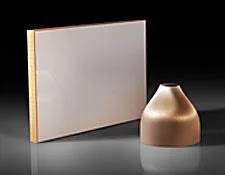Projection Stones!
used to view a tiny Halfland fly puppet, about the size of your little fingernail.
the stone gives the puppet a greater reality under its unique effect.
(There are two specific clues to whether this sort of slab is Ulexite or not. One is the viewing angle. Ulexite lifts the image to the surface in a way that remains visible from as much as 6 degrees off center. I'm unsure if what I'm viewing is 6 degrees or not, but the effect appears to disappear if I'm not directly above the object. Another test is whether there are concentric circles of light visible when a light is shone through the stone. I tried various lights but couldn't see any concentric circles appear. There are other clues, such as inclusions and fissures, but those also occur in different minerals. So I don't know what I have.)
It's strange, because if the slabs I have are not Ulexite, they certainly give a similar effect to what I was expecting. I looked for a long while for other sources for pieces of Ulexcite. Maddeningly, one of the world's most significant sources for it is located less than 150 miles from where I live in California, but it might as well be on another planet.
So I won't continue to look for any more pieces to experiment with. I may find a way to use the precious bits I have for a particular shot here or there. Or as a viewer in front of a small screen running the finished scene. (Or both at once, filming a clip playback through the stone within a scene capture.)
I love the effect and that it's a naturally occurring mineral. It's like snatching the digital-ness out of Halfland and giving it right back to the magic of nature. Take a look...
AI sez:: * Ulexite is a mineral, sometimes referred to as "television rock" or "TV rock," known for its unique optical properties. When a polished piece of ulexite is placed on a printed page, the text on the page can be seen on the surface of the stone, resembling a television screen. This effect is due to the mineral's fibrous structure, which acts like a fiber optic cable, transmitting light and images.
Here's a more detailed explanation:
- Fiber Optic Properties: Ulexite's natural fiber structure allows it to transmit light and images through its surface.
- TV Rock Nickname: Due to this ability to project images, ulexite is nicknamed "TV rock".
- Composition: Ulexite is a sodium-calcium borate mineral.
- Find Locations: It's often found in evaporite deposits and can be found in places like Boron, California.





Cool!
ReplyDeleteIt reminds me of this: https://en.wikipedia.org/wiki/Sunstone_(medieval)
Jill
Hi, Jill! Thank you for sending the page on sun stone. I relished every word on it! Thousand percent fascinating! I’d never even remotely heard a peripheral whisper of such objects in history. I’m blown away by the mystical quality of navigation via essentially a crystalline mineral. Given we have no known record or memory of how they were used, it is now a magical notion. I love that it was apparently allegorical as well as practical. Now I’ll have the lovely detail of Rana using the stone to find the desert in the secret season! Thank you for that Mystical arcana for this!
Delete